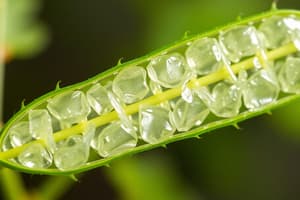Podcast
Questions and Answers
What is the primary function of chloroplasts in plants?
What is the primary function of chloroplasts in plants?
- Cell division
- Photosynthesis (correct)
- Cellular respiration
- Protein synthesis
Which structure within the chloroplast is responsible for light reactions during photosynthesis?
Which structure within the chloroplast is responsible for light reactions during photosynthesis?
- DNA chloroplast
- Stroma
- Grana (correct)
- Ribosomes
What type of DNA do chloroplasts possess?
What type of DNA do chloroplasts possess?
- Circular DNA (correct)
- Fragmented DNA
- Double-stranded RNA
- Linear DNA
Which part of the chloroplast is selectively permeable and plays a crucial role in controlling the internal environment?
Which part of the chloroplast is selectively permeable and plays a crucial role in controlling the internal environment?
What pigment is primarily involved in capturing light energy during photosynthesis?
What pigment is primarily involved in capturing light energy during photosynthesis?
What is the range of sizes for chloroplasts typically found in plant cells?
What is the range of sizes for chloroplasts typically found in plant cells?
What is the role of carotenoid pigments in chloroplasts?
What is the role of carotenoid pigments in chloroplasts?
What process occurs in the stroma of chloroplasts?
What process occurs in the stroma of chloroplasts?
Flashcards are hidden until you start studying
Study Notes
Struktur Kloroplas
-
Definisi: Kloroplas adalah organel sel yang ditemukan pada tumbuhan dan beberapa alga, berfungsi dalam proses fotosintesis dengan mengubah cahaya matahari menjadi energi kimia.
-
Bentuk dan Ukuran:
- Bentuk umumnya oval atau bulat.
- Ukuran bervariasi, biasanya berkisar antara 2-10 mikrometer.
-
Dua Membran:
- Membran luar: Halus dan permeabel, memungkinkan molekul kecil dan ion masuk dan keluar.
- Membran dalam: Lebih selektif, membentuk struktur yang lebih kompleks di dalam kloroplas.
-
Stroma:
- Ruang di dalam membran dalam kloroplas.
- Terdapat enzim, DNA kloroplas, ribosom, dan berbagai molekul penting lainnya.
- Tempat berlangsungnya siklus Calvin dalam fotosintesis.
-
Tilakoid:
- Struktur berbentuk kantong pipih yang terlipat membentuk tumpukan (grana).
- Memiliki membran tilakoid yang mengandung pigmen klorofil.
- Tempat berlangsungnya reaksi terang fotosintesis.
-
Grana:
- Tumpukan tilakoid yang saling terhubung.
- Meningkatkan efisiensi penangkapan cahaya.
-
Pigmen:
- Klorofil a dan b: Pigmen utama yang terlibat dalam penangkapan cahaya.
- Karotenoid: Pigmen tambahan yang membantu dalam penyerapan cahaya dan melindungi dari kerusakan oksidatif.
-
Fungsi Kloroplas:
- Fotosintesis: Mengubah cahaya matahari menjadi glukosa dan oksigen.
- Simpanan energi: Menghasilkan dan menyimpan energi dalam bentuk ATP dan NADPH.
-
DNA Kloroplas:
- Kloroplas memiliki DNA sirkuler yang mirip dengan DNA bakteria, mendukung teori endosimbiosis.
-
Ribosom:
- Ribosom yang ada di kloroplas berukuran lebih kecil (70S) dibandingkan dengan ribosom sel eukariotik (80S), menunjukkan hubungan evolusi dengan prokariota.
Struktur kloroplas yang kompleks memungkinkan proses fotosintesis berfungsi dengan efisien dalam menjamin kehidupan tumbuhan dan ekosistem secara keseluruhan.
Structure of Chloroplasts
- Definition: Chloroplasts are organelles found in plants and some algae, crucial for photosynthesis, converting sunlight into chemical energy.
- Shape and Size: Generally oval or circular; sizes range from 2 to 10 micrometers.
- Double Membrane System:
- Outer Membrane: Smooth and permeable, allowing small molecules and ions to pass.
- Inner Membrane: More selective, contributing to the complex internal structure of the chloroplast.
Internal Components
-
Stroma:
- The space inside the inner membrane.
- Contains enzymes, chloroplast DNA, ribosomes, and essential molecules.
- Site of the Calvin cycle during photosynthesis.
-
Thylakoids:
- Flat, bag-like structures folded into stacks (grana).
- Thylakoid membranes contain chlorophyll pigments.
- Location of light-dependent reactions of photosynthesis.
-
Grana:
- Stacks of thylakoids interconnected.
- Enhance light capture efficiency.
Pigments
- Chlorophyll a and b: Main pigments involved in light absorption.
- Carotenoids: Additional pigments that assist in light absorption and provide protection from oxidative damage.
Functions of Chloroplasts
- Photosynthesis: Converts sunlight into glucose and oxygen.
- Energy Storage: Produces and stores energy as ATP and NADPH.
Genetic Material
- Chloroplast DNA: Circular DNA resembling bacterial DNA, supporting the endosymbiotic theory.
Ribosomes
-
Chloroplast Ribosomes: Smaller (70S) than eukaryotic ribosomes (80S), indicating an evolutionary relationship with prokaryotes.
-
The complex structure of chloroplasts enables efficient photosynthesis, essential for plant life and overall ecosystem functionality.
Studying That Suits You
Use AI to generate personalized quizzes and flashcards to suit your learning preferences.




